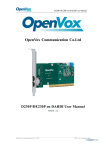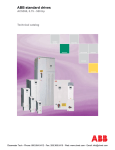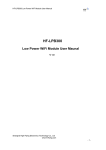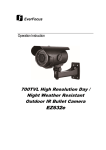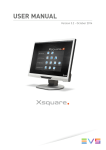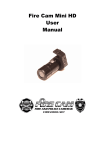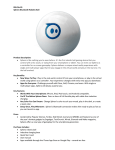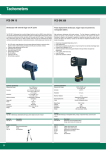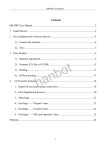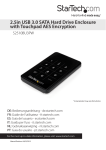Download 099AACO manual 2.0 - TFC Group Limited
Transcript
Cat No. 099A Digital Programmable Thermostat for Weekday/Weekend Setting User Maunal TABLE OF CONTENT 1 INTRODUCTION……………………………………. 2 2 INSTALLATION…………………………………….…4 3 SETTING CLOCK …………………………………. 11 4 SETTING PROGRAM……………………………...12 5 SLEEP OPERATION MODE……………………… 15 6 MANUAL OVERRIDE …………………………...…15 7 HEATER OPERATION……………………………..17 8 LOW BATTERY OPERATION……………………. 18 9 SPECIFICATIONS…………………………………. 19 1 1 INTRODUCTION This thermostat can replace most common indoor residential thermostat and is designed to be used with electric, gas or oil heating system. 1.1 Outlook 2 1.2 LCD 1.3 Features Several useful functions and operating modes have been incorporated to adapt a variety of customer needs. • LCD shows the “NEED TO KNOW” Information only, which is more easy to understand • 8 Changeable Programs (4 programs for weekday; 2 programs each for Saturday and Sunday) • Real Time Clock with Day of Week Display • Room Temperature Display 3 • • • • • • • • Simplified Temperature Adjustment Simplified Programming Procedure Manual Set-Temperature Override 2 x AAA Size Alkaline Batteries Operation (Not Included) Low Battery Indication Heater Operation Mode Sleep Operation Mode Slim Housing Design 2 INSTALLATION This thermostat has been designed for simple and quick installation requiring only a few tools. CAUTION: 1. The appliance can only be mounted on dry indoor places. 2. A suitable fuse with rating not exceeding 5A, should be in the power line. 3. Observe the national regulation for the wiring. 4. Qualified electrician is recommended for installation and servicing. 4 2.1 Required Material Hammer Masking tape Drill and 3/16” drill bit Screwdriver 2.2 Removing your old thermostat CAUTION: To avoid electric shock, turn off the power of the heating system at the main power box in your home. Read the following instructions carefully before disconnecting the wires. 1. Turn off the old thermostat. 2. Remove the cover from the old thermostat. 3. Unscrew the old thermostat from the wall plate. 4. Find and remove the screws attaching the wall plate to the wall. Pull the wall plate a small distance from the wall. Do not disconnect any wire yet, simply locate the wires. 5 Warning: After removing the wall plate, if you find that it is mounted on a junction box (e.g. a box similar to one behind a light switch or electric outlet), high voltage circuit may be present and there is a danger of electric shock. Please consult a qualified electrician. 2.3 Wire Labeling 1. Disconnect and identify each wire. 2. Tape the wires to the wall to keep them from slipping through the hole in the wall. If the hole in the wall is larger than necessary, fill it in order to prevent hot or cold air to penetrate the thermostat. In this manner, the thermostat will function perfectly. 2.4 Choosing a Location For a new installation, choose a mounting location: 1. About 5 feet (1.5 meter) above the floor in an area with good air circulation. 6 2. Away from: i. Drafts of dead air sports ii. Air ducts iii.Radiant heat from the sun or appliances iv.Concealed pipes and chimneys 3. The best viewing angle is 12 o’clock direction as shown in figure. 2.5 Mounting 1. Mounting the thermostat onto the wall. 2. Remove completely the front housing of the thermostat by using a screwdriver.(see picture) 3. Mark the holes’ position and align the wire coming from the wall in the hole beside the connectors.(see picture) 4. Drill two holes and insert the plastic anchors carefully into the holes until they are flush with the wall. 5. Fasten securely the thermostat to the wall with the two screws. 7 2.6 Connecting the Wires 1. Connect the system wires to the terminals according to the wiring diagram shown in the section 2.7 “WIRING DIAGRAM”. 2.7 Wiring Diagram The DRT2 thermostat can be used with single stage heating system. Inside the thermostat, three terminals which label COM, NC and NO would be found. Connect the heater to the terminal COM and NO (or NC de- 8 pends on the type of heater), In most case, COM and NO are used. 2.8 Battery Installation The DRT2 is operated by two AAA 1.5V Alkaline batteries. Please follow the installation instruction: 1. Find out the battery door at the side of the case. 2. Slide the door upward to open it. 3. Two old batteries would “jump out”. 4. Take out the old batteries. 5. Insert two batteries in right position as shown. Be sure the polarity of the batteries are in right position. 6. Push and slide the door down to close it. 9 If first use, skips the instruction (3) and (4). 2.9 Temperature Span Span is the temperature difference between the turn ON and OFF temperature. The factory pre-set span is 2˚C. For example, control temperature setting is 20.0˚C. The heater will be operated when the room temperature drops to 19.5˚C and will be turned off when the temperature rises to 21˚C. 2.10 Temperature Measurement ‘HI’ will be shown when temperature is above 40˚C and ‘LO’ will be shown when temperature falls below 0˚C. 2.11 Power Installation The thermostat is operated at two AAA size 1.5V Alkaline batteries. 10 To power-up the unit, installs battery as shown in above section “Battery Installation”. When power is applied for the first time or reset button is pressed, the display will show as follows: TIME 0:00 DAY TEMPERATURE OUTPUT MONDAY 22˚C OFF If the display is different as shown, use a fine probe such as straightened paper clip to gently push the reset button. 3 SETTING CLOCK 1. Press one of D, H or M button to set clock. Only the day of week and the time are displayed. 2. Press D button to adjust the day of week. 11 3. Press H button to adjust the hour digits. 4. Press M button to adjust the minute digits. 5. Hold D, H or M button about 3 seconds to fast advance the day, hour or minute adjustment rate respectively. 6. Press R button to return to normal operation mode. 7. The unit will return to normal operation mode if no key is pressed for 10 seconds. 4 SETTING PROGRAM 4.1 Pre-recorded Programs Program 1 2 3 4 5 6 7 8 Day of Week Time Temp for Heat Control Weekday 6:00 20˚C (Mon - Fri) 8:30 14˚C 16:00 20˚C 22:00 14˚C Saturday 7:00 20˚C 23:00 14˚C Sunday 7:30 20˚C 22:00 14˚C 12 1. After power up or reset, press P button to view the prerecorded programs. All the programs are factory preset at the above values. 2. Press P button again will scroll weekday (P1 - 4), Saturday (P5 - 6) and Sunday (P7 - 8) programs. 3. The program is set as a sequence: P1 » P2 » ... » P8 » P1 » ... 4.2 Program Modification The pre-recorded programs could be modified. Follow the instructions shown below. 1. Press P button to select program (P1 - P8). 2. Press H button to set the hour indicator. 3. Press M button to increase the minute indicator setting by 15 minutes each time. 4. Press ▲ or ▼ button to adjust to your desired set 13 temperature. Temperature will be increased or decreased by 0.5˚C for each press. 5. Program temperature can only be set in the control temperature range from 5˚C to 35˚C, not wrap around at two ends. 6. Press D button will turn on or off the program. For example, you want to turn off program 2, press P button to select program 2. Then press D button. Program 2 is off as shown beside. Press D button again will turn on the program. 7. Hold H, M, ▲or ▼ button about 3 seconds to fast advance the hour, minute, or temperature adjustment rate respectively. 8. Press R button to store the settings and back to normal operation mode. 9. The settings will be stored automatically and back to normal operation mode when no button is pressed about 10 seconds. 14 5 SLEEP OPERATION MODE Sleep operation is used to save power when not use. Pressing the ▲ and ▼ simultaneously about 5 seconds will activate the sleep operation mode. When enter the sleep operation mode, all function will be paused, the LCD will be blank and the relay will turn off. Pressing any key to call the unit wake up. 6 MANUAL OVERRIDE At the normal operation mode, the current temperature setting could be overridden until the next program comes. 1. Press ▲ or ▼ button to view the overriding temperature which is set last time. 2. Hold ▲ or ▼ button about 3 seconds and the temperature indicator will flash one time. 15 3. Press ▲ or ▼ button to decrease or increase the temperature setting. 4. Hold ▲ or ▼ button to fast advances the adjustment rate. 5. Press R button to terminate the setting procedure and back to normal mode with the new temperature setting. 6. The unit will be back to normal operation mode automatically when no button is pressed about 10 seconds. 7. Program temperature can only be set in the control temperature range from 5˚C to 35˚C, not wrap around at two ends. When pressing the ▲ button to increase the temperature to 35˚C, the “up arrow” of the Manual Override Icon will be turned off as shown. 16 Likewise, when pressing ▼ button to decrease the temperature to 5˚C, the “down arrow” of the Manual Override Icon will be turned off as shown. 7 HEATER OPERATION 7.1 Heater On Operation The heater will be turned on by setting programs or manual override. If the heater is turned on by setting programs, the Program Number, and the Heater On Icon will be displayed as shown. If the heater is turned on by manual override, only the Heater On Icon will be displayed as shown. 17 7.2 Output-On Delay For safety purposes, the thermostat has an auto 20 seconds’ delay for heater to restart. 8 LOW BATTERY OPERATION When the voltage of the battery decrease to certain level, the low battery indicator will be turned on and the thermostat cannot detect the temperature anymore. When the battery indicator is turning on, the batteries should be changed as soon as possible to avoid any data loss. 18 9 SPECIFICATIONS 9.1 Physical Characteristics Size: Material: Weight: 73.5 (W) X 28.0 (L) X 73.5 (H) mm Polycarbonate (PC) 94g (battery not included) 9.2 Electrical Characteristics AAA 1.5V Alkaline battery x 2 (not included) Power Source: Switching Relay: Resistive load: Inductive load: Clock Accuracy: Temperature Measurement: Temperature Accuracy: Temperature Control: Temperature Control Span: 19 5A at 250VAC 3.5A at 250VAC ±60 seconds/month 0 - 40˚C ±1.0˚C 5 - 35˚C 2˚C Output On Delay: Operating Temperature: 20 seconds -10˚C to 50˚C (non-condensing) -30˚C to 60˚C Storage Temperature: 20






















